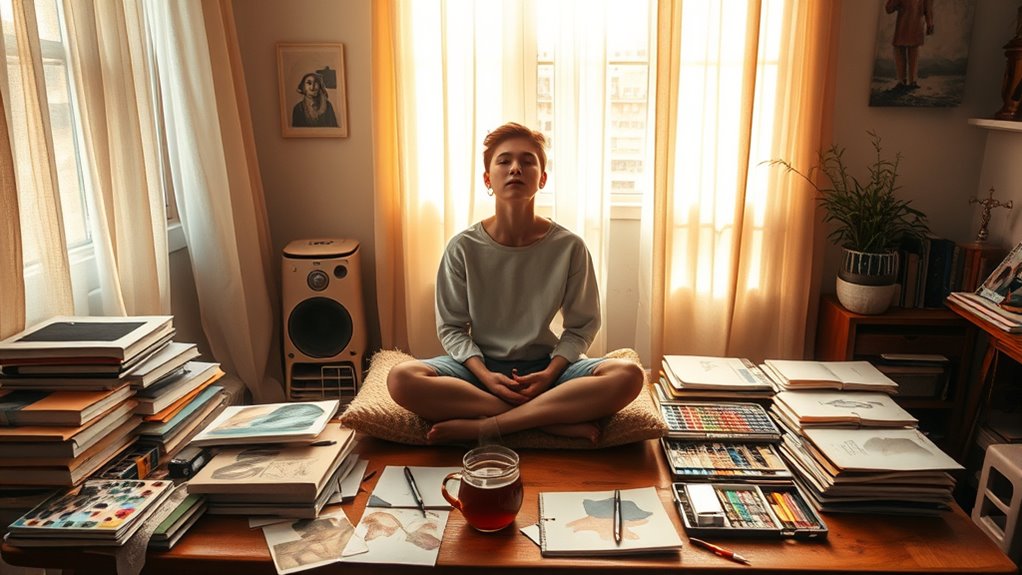Practicing mindfulness helps you open your creative flow by sharpening your focus, calming mental chatter, and deepening your connection to the present moment. When you stay present, you create mental space for ideas to emerge naturally and feel more authentic. This state of awareness encourages spontaneous discovery and makes your creative process more fluid and enjoyable. Keep exploring; you’ll soon discover how consistent mindfulness practice can continuously open your flow state and boost your creativity.
Key Takeaways
- Mindfulness cultivates a focused, non-judgmental awareness that reduces mental chatter and facilitates entry into flow states.
- Practicing meditation enhances connection to the present moment, unlocking spontaneous insights and creative energy.
- Mindfulness heightens sensitivity to subtle details, enriching artistic perception and fostering original ideas.
- Regular mindful practices decrease fear of failure, encouraging experimentation and seamless creative expression.
- Embracing presence shifts focus from outcome to process, sustaining motivation and deepening engagement in creative work.

Have you ever wondered how being present in the moment can boost your creative thinking? When you focus your attention fully on what you’re experiencing right now, you tap into a wellspring of inspiration. This is where meditative practices come into play. By cultivating a mindful state through meditation, deep breathing, or simple awareness exercises, you create mental space that allows your ideas to flow freely. These practices quiet the chatter of your mind, reduce stress, and help you connect more deeply with your inner self, making it easier to access your innate creativity. When you’re mindful, your perception shifts from distraction and judgment to curiosity and openness, which are essential for artistic expression. The more you practice being present, the more natural it becomes to enter a flow state—an ideal zone where your creative energy feels limitless.
In this flow, you’re less hindered by self-doubt or overthinking. Instead, you allow your ideas to unfold organically, without forcing or controlling them. Meditative practices foster this mental environment by helping you detach from external pressures and internal critic voices. As a result, your artistic expression becomes more authentic and fluid. You might find yourself sketching, writing, or playing music with a sense of ease that wasn’t there before. This heightened state of awareness not only enhances your ability to generate original ideas but also improves your focus and emotional connection to your work. When you’re fully present, you’re more attuned to subtle details, textures, and nuances that elevate your creative projects. Additionally, understanding the power of mindfulness can deepen your appreciation for the creative process and help sustain your motivation over time.
Furthermore, mindfulness encourages a non-judgmental attitude toward your work, which is vital for experimentation and growth. Instead of worrying about perfection or outcomes, you learn to appreciate the process of creation itself. This shift reduces fear of failure and encourages you to take risks, explore new techniques, and push boundaries. As you incorporate regular meditative practices into your routine, you’ll notice a greater ease in accessing your creative flow. Artistic expression becomes less about effort and more about spontaneous discovery. Over time, this mindful approach transforms your creative process into a more enjoyable, fulfilling journey. You’ll find that the more you cultivate presence, the more natural it feels to step into your flow state and access your full artistic potential.
Frequently Asked Questions
How Does Mindfulness Physically Alter Brain Activity Related to Creativity?
When you practice mindfulness, it increases neural activation in brain regions linked to creative thinking, like the prefrontal cortex. It also enhances brain connectivity, allowing different areas to communicate more effectively. This heightened connectivity helps you access diverse ideas and insights, fostering creativity. By calming your mind, mindfulness reduces distractions, enabling your brain to enter a flow state where creative ideas flow more freely and effortlessly.
Can Mindfulness Practices Be Tailored for Different Creative Disciplines?
Yes, you can tailor mindfulness practices for different creative disciplines by using discipline-specific techniques and personalized mindfulness strategies. For example, visual artists may benefit from guided imagery, while writers might prefer focused breathing exercises. Adjusting practices to suit your creative focus helps deepen your flow state, enhances creativity, and keeps you engaged. Personalization guarantees that your mindfulness routine aligns with your unique process, making it more effective and sustainable.
What Are Common Barriers to Entering the Flow State Through Mindfulness?
You might find your mind drifting like a boat on choppy waters, making distraction management tough. Emotional barriers, such as self-doubt or anxiety, act like storm clouds blocking your clear sky of focus. These obstacles keep you from slipping into the flow state. To sail smoothly, you must navigate distractions carefully and confront emotional barriers head-on, clearing the way for unbroken creative currents to carry you effortlessly forward.
How Long Does It Typically Take to See Creative Improvements From Mindfulness?
You might see creative progress in just a few weeks with consistent mindfulness practice, but it varies based on your mindfulness duration and effort. Regular daily sessions of 10-20 minutes can steadily enhance your ability to access the flow state. Over time, you’ll notice increased clarity, inspiration, and innovation, as mindfulness helps you stay present and receptive to new ideas, accelerating your creative growth.
Are There Any Risks or Downsides to Using Mindfulness for Creativity Enhancement?
Like walking a tightrope, using mindfulness for creativity can be risky if you overdepend on it. While it boosts mental health, leaning too heavily might stifle spontaneous ideas or create dependency, making it harder to generate creativity without it. Stay balanced; mindfulness should be a tool, not a crutch. Overuse can lead to mental fatigue or complacency, so practice moderation to keep your creative flow healthy and vibrant.
Conclusion
By blending mindfulness with your creative pursuits, you open a boundless brain where brilliance blooms. Embrace each moment mindfully, making space for inspiration to ignite. When you nurture this natural nexus, you notice new nuances, nurturing your knack for novelty. So, seize the serenity, spark the spontaneous, and step into the seamless flow of your creative flow state. Remember, with mindfulness, your imagination’s infinite potential is simply waiting to be awakened.









